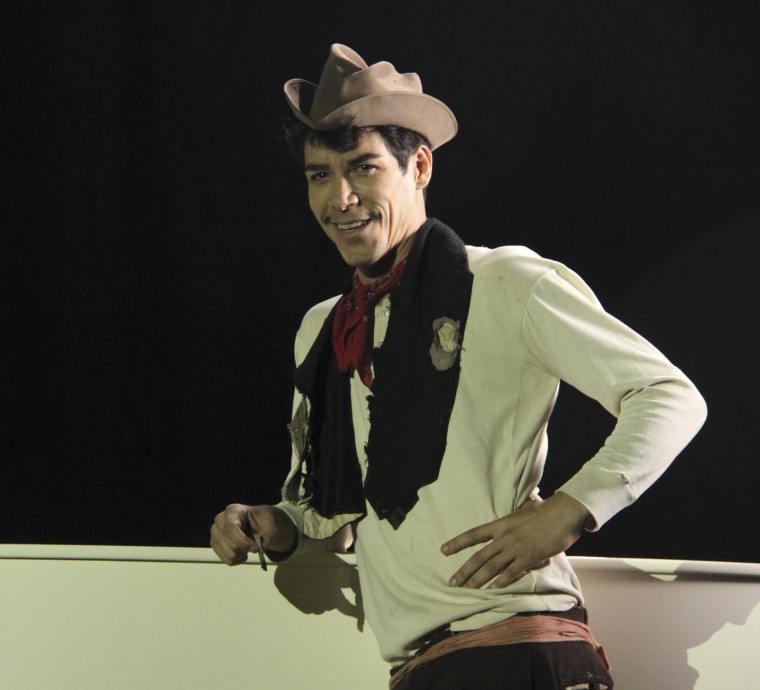Sometime in the early 1980s, in an unlikely place – NASA’s Johnson Space Center in Houston – an elegantly dressed man wearing thick, dark-rimmed eyeglasses came rounding a corner with a tour guide at his elbow, unnoticed by the throngs of mostly Anglo tourists.
This was not the case, however, with one museum visitor, my then-mother-in-law Martha. A sweet woman normally reserved in public, Martha did not believe we landed on the moon, so she was not impressed with the many rockets on display. She was, however, bowled over when she spotted the man, the legendary Mexican actor Mario Moreno, known to legions across Latin America and Martha’s native Mexico, as their beloved Cantinflas. Martha breathlessly scurried up to Moreno, placed a firm hand on his shoulder and blurted, “Cómo estás, Cantinflas?” With a look equal parts delight and surprise, Moreno shook her hand, smiled and replied in a tone almost matching her enthusiasm that he was fine, thank you.
That Martha greeted Mexico’s and one of Latin America's most celebrated comic actor as if she had run into an old friend at the market seemed only right. After all, Cantinflas’ black and white movies, shown on the big screen and seemingly nightly on Spanish-language television in South Texas, were a staple of Martha’s life, just as they were for millions of Latinos in the U.S., Central and South America and the Spanish-speaking Caribbean. Moreno’s fans virtually idolized him for his portrayals of the poor underdog who, often through wit and guile, triumphed over more monied and powerful foes. For many Mexicans and Spanish-speakers in different countries, Cantinflas was not just an Everyman, he was one of them.
Long before breaking into the movies, Moreno laid the foundation for his Cantinflas character in traveling tent theater circuits, performing as one of Mexico’s “peladitos,” clowns who cast a critical eye on politicians, culture and the upper class.
“It’s how people could relate to Cantinflas,” said Nicolás Kanellos, a cultural historian and professor at the University of Houston. “The majority of people from the working class and the lower middle class could identify with his undermining of established institutions.”
Moreno died in 1993, but now a biopic, “Cantinflas,” is reacquainting old fans and Spanish-speaking moviegoers with his story, as well as introducing the cultural icon to younger U.S. Latinos.

How “Cantinflas” fares will be watched closely by the movie industry, which only recently has tried tapping into the prime Hispanic market. Hispanics are the most avid moviegoers in the country. A 2013 Motion Picture Association of America report found that though Hispanics represented 17 percent of the moviegoing population, they accounted for nearly 1 in 3 of all frequent moviegoers, those who went to a movie more than once a month. There’s no business like repeat business, where Latinos could hold a key for the movie industry.
Judging by early box office returns, “Cantinflas,” mostly in Spanish with English subtitles, is connecting with U.S. Hispanic audiences. In its opening weekend, the movie made over $2.6 million, nearly recouping the very modest-by-Hollywood standards $3.2 million it cost to make. It had the highest per-screen average, even beating out the much-anticipated and expensive summer blockbuster, “Guardians of the Galaxy.”
Cantinflas was released Thursday, September 18 in Mexico and rollouts across Central and South America, where its prospects seem bright.
U.S. Hispanics are hungry for their stories to be told, says cultural historian Nikolás Kanellos, but is not being done by current filmmakers. “They don’t really plumb the depths of our society.”
The movie industry report found that for Latinos, moviegoing is often a family experience, a phenomenon not lost on “Cantinflas” director Sebastian del Amo, who spoke to NBC News from his home in Mexico City. Much of the film is set in the Golden Age of Mexican cinema and depicts Moreno’s journey to stardom from the 1920s to the 1950s, not exactly prime subject matter for younger audiences.
Still, “first- and second-generation Latinos, some who spoke little or no English, saw the movie with their mothers or their grandparents, who grew up with Cantinflas movies,” Del Amo said. “The movie brought families together. That was amazing.”
Cantinflas’ comedy was “very local, and very Mexican,” hinging on his status as a Mexico City slum dweller, said del Amo. Yet his appeal transcended borders too. Often called the Charlie Chaplin of Latin America, Moreno became an ambassador of Mexican culture around the world, the director said.
Though he made dozens of movies, Moreno was best known to non-Hispanic Americans for his role in the Hollywood mega-production, “Around the World in 80 Days.” He has a star on the Hollywood Walk of Fame.
Hollywood’s interest in Latino subjects and themes comes as the U.S. Hispanic population continues to boom. It now stands at over 54 million, making Hispanics the second-largest racial or ethnic group in the country, the Pew Research Center said this week.
Diego Luna, who directed the biopic “Cesar Chavez,” told journalists in Austin, where the film won the Audience Award at the South by Southwest Film Festival last March, that it is important for Latinos to support Latino-focused films. Getting financing for the movie was not easy, the Mexican actor explained, and studios needed to be convinced that there is an audience for films like “Chavez,” Luna said, adding that a poor showing at the box office would send a bad message.
Expect to see more films about Hispanics. Filmmakers, said del Amo, can’t ignore that “the importance of the Latino culture is everywhere in the U.S.”
And because of demographics, “there’s going to be writers and producers looking for aspects of Latino life to put on all types of screens,” said Kanellos, the cultural historian. “From your phone to the big screen.”
The founder of Arte Público Press, the nation’s oldest publisher of Hispanic books in the U.S., Kanellos said Hispanics are hungry for their stories to be told. Filmmakers, however, tend to represent Latinos through sensationalism and depictions of violence, gangs and drugs.
“They don’t really plumb the depths of our society,” Kanellos said. “What’s important for Latinos is to see their particular lives and struggles within the United States, and our particular perspective on American life.”
